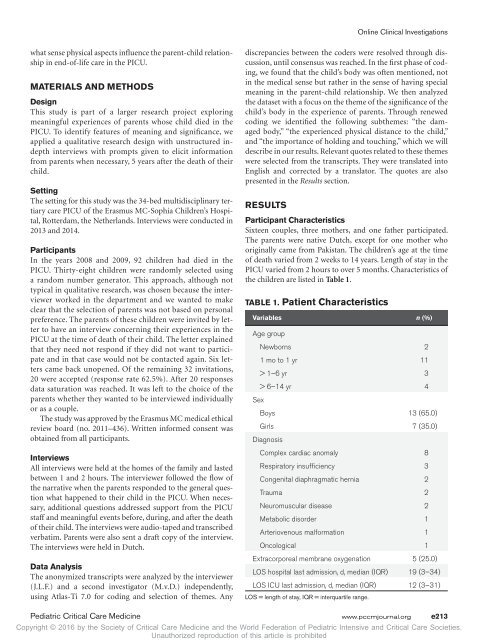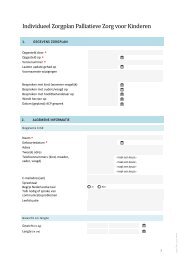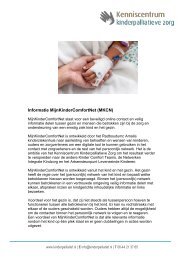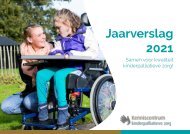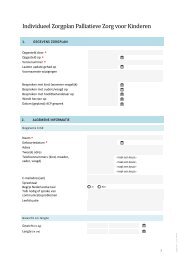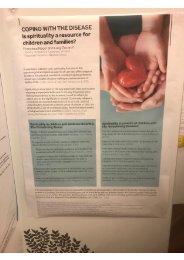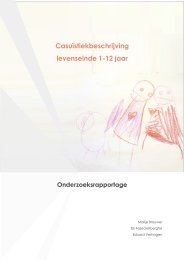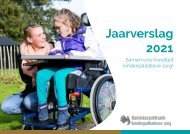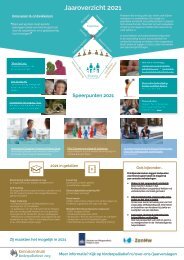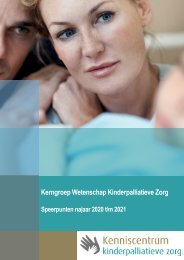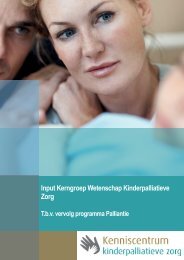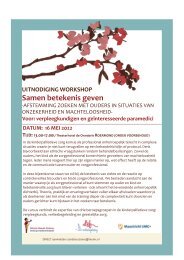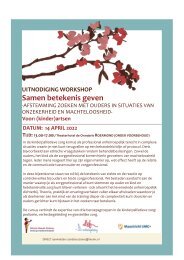Parental physical proximity in end-of-life care in the PICU
Create successful ePaper yourself
Turn your PDF publications into a flip-book with our unique Google optimized e-Paper software.
Onl<strong>in</strong>e Cl<strong>in</strong>ical Investigations<br />
what sense <strong>physical</strong> aspects <strong>in</strong>fluence <strong>the</strong> parent-child relationship<br />
<strong>in</strong> <strong>end</strong>-<strong>of</strong>-<strong>life</strong> <strong>care</strong> <strong>in</strong> <strong>the</strong> <strong>PICU</strong>.<br />
MATERIALS AND METHODS<br />
Design<br />
This study is part <strong>of</strong> a larger research project explor<strong>in</strong>g<br />
mean<strong>in</strong>gful experiences <strong>of</strong> parents whose child died <strong>in</strong> <strong>the</strong><br />
<strong>PICU</strong>. To identify features <strong>of</strong> mean<strong>in</strong>g and significance, we<br />
applied a qualitative research design with unstructured <strong>in</strong>depth<br />
<strong>in</strong>terviews with prompts given to elicit <strong>in</strong>formation<br />
from parents when necessary, 5 years after <strong>the</strong> death <strong>of</strong> <strong>the</strong>ir<br />
child.<br />
Sett<strong>in</strong>g<br />
The sett<strong>in</strong>g for this study was <strong>the</strong> 34-bed multidiscipl<strong>in</strong>ary tertiary<br />
<strong>care</strong> <strong>PICU</strong> <strong>of</strong> <strong>the</strong> Erasmus MC-Sophia Children’s Hospital,<br />
Rotterdam, <strong>the</strong> Ne<strong>the</strong>rlands. Interviews were conducted <strong>in</strong><br />
2013 and 2014.<br />
Participants<br />
In <strong>the</strong> years 2008 and 2009, 92 children had died <strong>in</strong> <strong>the</strong><br />
<strong>PICU</strong>. Thirty-eight children were randomly selected us<strong>in</strong>g<br />
a random number generator. This approach, although not<br />
typical <strong>in</strong> qualitative research, was chosen because <strong>the</strong> <strong>in</strong>terviewer<br />
worked <strong>in</strong> <strong>the</strong> department and we wanted to make<br />
clear that <strong>the</strong> selection <strong>of</strong> parents was not based on personal<br />
preference. The parents <strong>of</strong> <strong>the</strong>se children were <strong>in</strong>vited by letter<br />
to have an <strong>in</strong>terview concern<strong>in</strong>g <strong>the</strong>ir experiences <strong>in</strong> <strong>the</strong><br />
<strong>PICU</strong> at <strong>the</strong> time <strong>of</strong> death <strong>of</strong> <strong>the</strong>ir child. The letter expla<strong>in</strong>ed<br />
that <strong>the</strong>y need not respond if <strong>the</strong>y did not want to participate<br />
and <strong>in</strong> that case would not be contacted aga<strong>in</strong>. Six letters<br />
came back unopened. Of <strong>the</strong> rema<strong>in</strong><strong>in</strong>g 32 <strong>in</strong>vitations,<br />
20 were accepted (response rate 62.5%). After 20 responses<br />
data saturation was reached. It was left to <strong>the</strong> choice <strong>of</strong> <strong>the</strong><br />
parents whe<strong>the</strong>r <strong>the</strong>y wanted to be <strong>in</strong>terviewed <strong>in</strong>dividually<br />
or as a couple.<br />
The study was approved by <strong>the</strong> Erasmus MC medical ethical<br />
review board (no. 2011–436). Written <strong>in</strong>formed consent was<br />
obta<strong>in</strong>ed from all participants.<br />
Interviews<br />
All <strong>in</strong>terviews were held at <strong>the</strong> homes <strong>of</strong> <strong>the</strong> family and lasted<br />
between 1 and 2 hours. The <strong>in</strong>terviewer followed <strong>the</strong> flow <strong>of</strong><br />
<strong>the</strong> narrative when <strong>the</strong> parents responded to <strong>the</strong> general question<br />
what happened to <strong>the</strong>ir child <strong>in</strong> <strong>the</strong> <strong>PICU</strong>. When necessary,<br />
additional questions addressed support from <strong>the</strong> <strong>PICU</strong><br />
staff and mean<strong>in</strong>gful events before, dur<strong>in</strong>g, and after <strong>the</strong> death<br />
<strong>of</strong> <strong>the</strong>ir child. The <strong>in</strong>terviews were audio-taped and transcribed<br />
verbatim. Parents were also sent a draft copy <strong>of</strong> <strong>the</strong> <strong>in</strong>terview.<br />
The <strong>in</strong>terviews were held <strong>in</strong> Dutch.<br />
Data Analysis<br />
The anonymized transcripts were analyzed by <strong>the</strong> <strong>in</strong>terviewer<br />
(J.L.F.) and a second <strong>in</strong>vestigator (M.v.D.) <strong>in</strong>dep<strong>end</strong>ently,<br />
us<strong>in</strong>g Atlas-Ti 7.0 for cod<strong>in</strong>g and selection <strong>of</strong> <strong>the</strong>mes. Any<br />
discrepancies between <strong>the</strong> coders were resolved through discussion,<br />
until consensus was reached. In <strong>the</strong> first phase <strong>of</strong> cod<strong>in</strong>g,<br />
we found that <strong>the</strong> child’s body was <strong>of</strong>ten mentioned, not<br />
<strong>in</strong> <strong>the</strong> medical sense but ra<strong>the</strong>r <strong>in</strong> <strong>the</strong> sense <strong>of</strong> hav<strong>in</strong>g special<br />
mean<strong>in</strong>g <strong>in</strong> <strong>the</strong> parent-child relationship. We <strong>the</strong>n analyzed<br />
<strong>the</strong> dataset with a focus on <strong>the</strong> <strong>the</strong>me <strong>of</strong> <strong>the</strong> significance <strong>of</strong> <strong>the</strong><br />
child’s body <strong>in</strong> <strong>the</strong> experience <strong>of</strong> parents. Through renewed<br />
cod<strong>in</strong>g we identified <strong>the</strong> follow<strong>in</strong>g sub<strong>the</strong>mes: “<strong>the</strong> damaged<br />
body,” “<strong>the</strong> experienced <strong>physical</strong> distance to <strong>the</strong> child,”<br />
and “<strong>the</strong> importance <strong>of</strong> hold<strong>in</strong>g and touch<strong>in</strong>g,” which we will<br />
describe <strong>in</strong> our results. Relevant quotes related to <strong>the</strong>se <strong>the</strong>mes<br />
were selected from <strong>the</strong> transcripts. They were translated <strong>in</strong>to<br />
English and corrected by a translator. The quotes are also<br />
presented <strong>in</strong> <strong>the</strong> Results section.<br />
RESULTS<br />
Participant Characteristics<br />
Sixteen couples, three mo<strong>the</strong>rs, and one fa<strong>the</strong>r participated.<br />
The parents were native Dutch, except for one mo<strong>the</strong>r who<br />
orig<strong>in</strong>ally came from Pakistan. The children’s age at <strong>the</strong> time<br />
<strong>of</strong> death varied from 2 weeks to 14 years. Length <strong>of</strong> stay <strong>in</strong> <strong>the</strong><br />
<strong>PICU</strong> varied from 2 hours to over 5 months. Characteristics <strong>of</strong><br />
<strong>the</strong> children are listed <strong>in</strong> Table 1.<br />
Table 1. Patient Characteristics<br />
Variables n (%)<br />
Age group<br />
Newborns 2<br />
1 mo to 1 yr 11<br />
> 1–6 yr 3<br />
> 6–14 yr 4<br />
Sex<br />
Boys 13 (65.0)<br />
Girls 7 (35.0)<br />
Diagnosis<br />
Complex cardiac anomaly 8<br />
Respiratory <strong>in</strong>sufficiency 3<br />
Congenital diaphragmatic hernia 2<br />
Trauma 2<br />
Neuromuscular disease 2<br />
Metabolic disorder 1<br />
Arteriovenous malformation 1<br />
Oncological 1<br />
Extracorporeal membrane oxygenation 5 (25.0)<br />
LOS hospital last admission, d, median (IQR) 19 (3–34)<br />
LOS ICU last admission, d, median (IQR) 12 (3–31)<br />
LOS = length <strong>of</strong> stay, IQR = <strong>in</strong>terquartile range.<br />
Pediatric Critical Care Medic<strong>in</strong>e www.pccmjournal.org e213<br />
Copyright © 2016 by <strong>the</strong> Society <strong>of</strong> Critical Care Medic<strong>in</strong>e and <strong>the</strong> World Federation <strong>of</strong> Pediatric Intensive and Critical Care Societies.<br />
Unauthorized reproduction <strong>of</strong> this article is prohibited


